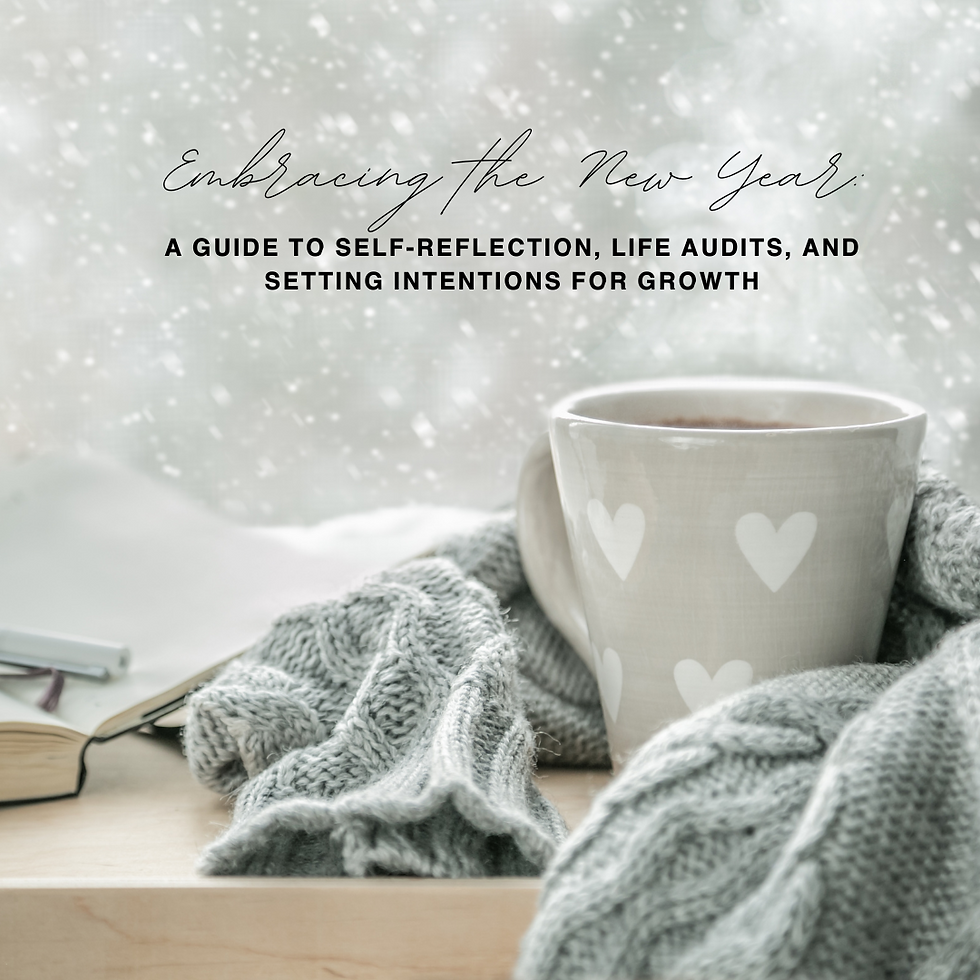Embracing the New Year: A Guide to Self-Reflection, Life Audits, and Setting Intentions for Growth
- alteregowellness
- Jan 8
- 4 min read
Updated: Jan 15

The new year is a time of renewal, a blank slate filled with endless possibilities. For many, it’s a moment to set goals, dream big, and embrace the future with open arms. But before diving into resolutions, consider taking a step back. The key to meaningful growth lies in reflection, understanding where you are now, and intentionally crafting where you want to go. In this article, we’ll explore how to embrace the new year with a life audit, actionable goal-setting, and practices to align with your highest potential.
The Power of New Beginnings
January marks a universal turning point. Across cultures, the new year symbolizes hope, progress, and opportunity. But why stop at hope? To fully embrace this season of change, we need clarity. While it’s tempting to set lofty resolutions, they often fail without a solid foundation rooted in self-awareness. Enter the life audit, a structured approach to evaluating where you are in different areas of your life. By identifying what’s working, what’s not, and what deserves your energy, you can ensure your goals align with your values and vision. I will be bringing you a more detailed introduction to the life audit, but read below for tips on how to utilize the life audit in your life today.
Step 1: Conducting Your Life Audit
A life audit is a way to pause and reflect on various facets of your life. It’s like spring cleaning, but for your mind, heart, and purpose. Here's how to get started:
1. Divide Your Life into Key Areas
Career: Are you fulfilled in your work? Are you growing or feeling stagnant?
Relationships: Are your connections enriching, supportive, and aligned with your values?
Health: How are you doing physically, mentally, and emotionally?
Finances: Are you financially secure and managing your resources well?
Personal Growth: Are you learning, evolving, and stepping out of your comfort zone?
Joy and Fun: Are you making time for what truly makes you happy?
Environment: Does your living or working space inspire and energize you?
2. Assess Each Area
Use a scale of 1 to 10 to rate your satisfaction in each area. Write down what’s going well, what could improve, and the specific changes you’d like to see.
3. Identify Patterns
Look for recurring themes. Are you overextending yourself in one area while neglecting another? Awareness is the first step toward balance.
4. Celebrate Wins
Don’t overlook the positives! Take a moment to appreciate the progress you’ve made and the strengths you’ve demonstrated.
Step 2: Set Intentions, Not Just Goals
Traditional resolutions often focus on specific outcomes: losing 10 pounds, saving a set amount of money, getting a promotion, etc. While these are valid, they can feel rigid or overwhelming. Instead, consider setting intentions, which are rooted in your values and the way you want to feel.
Examples of Intentions:
“I want to nurture my relationships with love and presence.”
“I aim to approach challenges with curiosity and resilience.”
“I commit to prioritizing my well-being and energy.”
When your goals flow from these deeper intentions, they become more meaningful and sustainable.
Step 3: Create an Action Plan
Once you’ve identified your intentions and goals, break them down into actionable steps. Here’s a simple framework:
Define Your Why: Tie each goal to a purpose that inspires you.
Break It Down: Outline smaller, manageable steps that lead to the larger goal.
Set a Timeline: Assign realistic deadlines to maintain momentum.
Build Accountability: Share your goals with a trusted friend, coach, or accountability partner.
Step 4: Incorporate Reflection into Your Routine
A life audit and goal-setting aren’t one-and-done activities. To stay aligned throughout the year, commit to regular check-ins. These can be weekly, monthly, or quarterly, whatever works for you.
Ask yourself:
What progress have I made?
What challenges have I encountered?
Do I need to adjust my goals or priorities?
Use resources like a paper calendar or calendar app to pencil in your check-ins as a non-negotiable.
Reflection helps you recalibrate and ensures your actions stay aligned with your values.
Step 5: Embrace Self-Compassion and Flexibility
Change isn’t linear. Life will throw curveballs, and that’s okay. When setbacks arise, treat yourself with kindness. Growth happens not because we’re perfect but because we keep going.
Tools to Support Your Journey
Here are a few tools and practices to deepen your reflection and keep you on track:
Journaling: A powerful way to process thoughts and track growth.
Vision Boards/Exercises: Visualize your dreams and keep them front of mind.
Meditation or Mindfulness Practices: Cultivate awareness and presence.
Coaching: A life coach can provide guidance, support, and accountability.
Closing Thoughts: You Are the Architect of Your Year
The new year isn’t about becoming someone different, it’s about stepping into the fullest expression of who you already are. By conducting a life audit, setting heartfelt intentions, and creating an actionable plan, you’re positioning yourself for a year of purpose and joy.
As a life coach, I’m here to support you every step of the way. Remember, growth isn’t about perfection, it’s about progress. Here’s to a transformative year ahead!
What are your intentions for the new year? Share them in the comments or reply to this email, I’d love to hear from you!
Cathryn Benjamin
Mindset & Life Coach | Yoga Teacher | Wellness Advocate
Follow me on Instagram for tips on living authentically, embracing wellness, and fostering a positive mindset.
Comments